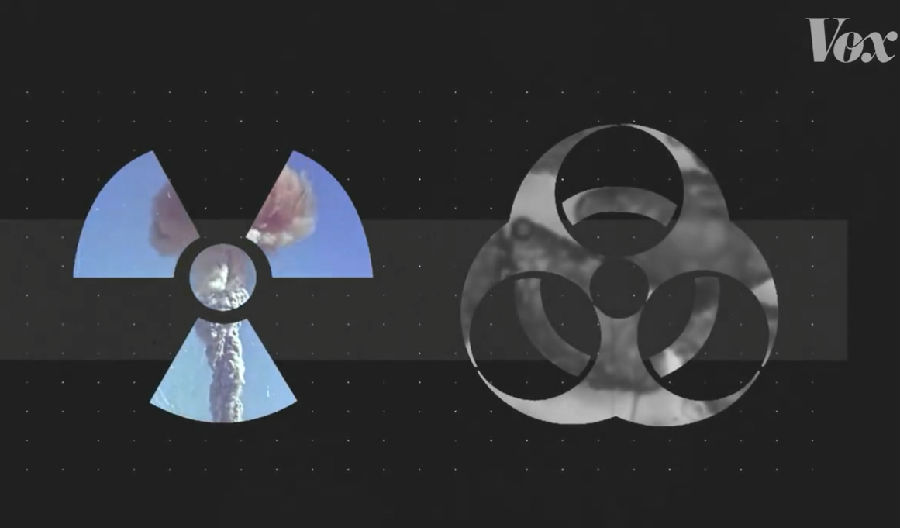(单词翻译:单击)
It’s easy to overlook how much visual communication work these symbols are doing.
我们很容易忽略这些标志对我们进行视觉沟通的重要性。
They’re simple — you only need a straightedge and a compass to recreate them.
它们都很简单——大家只需要一个直尺和一个圆规就能画出来。
And unlike most other hazard symbols, they don’t reference an existing physical object or idea.
然而,它们又不像大多数危险标志那样能够表示具体存在的物品或者思想。
But they’ve remained iconic for decades, helping people recognize serious dangers that may remain a threat for thousands of years to come.
但它们作为标志已经存在好几十年了,一直帮着人们识别那些可能在未来数千年内都依然具有危险性的高危物品。
And that raises the question: could the meaning of those symbols stand the test of time?
这就给我们提出了一个问题:这些标志的意义真的能够经受住时间的考验吗?
Few people have pondered that question quite like Gregory Benford.
很少有人像格里高利·本佛德那样关心这个问题。
He’s a physicist and science fiction author. In the 1990s, he was invited to work on the Waste Isolation Pilot Project, or WIPP.
他是一名物理学家兼科幻小说作家。九十年代,他受邀参加了废物隔离试验项目(简称“WIPP”)。
The WIPP is a massive storage site for radioactive waste in the southeastern plains of New Mexico, organized by the US Department of Energy.
该项目是美国能源部在新墨西哥东南平原布局的一个大规模辐射性废物储存站。
Benford was brought in to help calculate the probability that someone or something would intrude on the site for as long as it remains dangerous — approximately the next 10,000 years.
本佛德被邀请去帮助他们估计在储存站仍具危险性期间——可能是未来一万年内——人或动物闯入那里的概率。
“Well, name anything that has persisted for 10,000 years. Any institution. There isn't any
“我说,给我举个能够持续一万年的东西,随便哪个组织都行,但事实上,没有一个组织能够坚持一万年。
The record is probably something like the Catholic Church or the core of the Jewish religion, which tells us something about what really lasts.”
能够保持这一记录的可能是天主教或者犹太教核心教义那种告诉我们到底什么才能长久的东西。”
The meaning of a symbol can change over time. Like the Jolly Roger, which wouldn't work for the radioactive threat at the WIPP.
符号的意义会随着时间改变。海盗旗就不能拿来当废物隔离试验项目辐射危险区域的标志。
“If you're approaching the WIPP facility and you see a skull and crossbones you might think, ‘Hey this is where the pirates buried their treasure.’”
“如果你走到废物隔离试验项目基地,看到一个由骷髅和十字骨头组成的标志,你可能会觉得,“哈,这里肯定是海盗埋藏宝藏的地方”。”
So how do you indicate a long lasting danger across any language?
所以,我们要如何提示不同语言背景的人某处有长久性危险品呢?
Since the 1970s, engineers, anthropologists, physicists, and behavioral scientists have proposed different solutions to that problem.
七十年代以来,工程师、人类学家、物理学家和行为学家纷纷提出了各种各样的解决方案。
One strategy was to add context to the symbol.
其中就有为标志提供语境的建议。
By illustrating cause and effect in a threepart cartoon like this, designers could communicate the idea even if the symbol lost its meaning.
用这种三段式卡通表明因果,这样一来,即便符号不能表明其意义,设计师们还是能够向大家传达他们的设计意图。
But this kind of visual communication still made a lot of assumptions about the user:
但这种视觉沟通方法仍然是基于对用户的诸多预设做出来的:
that they would read left to right, that they would understand causality between frames — and, of course, that the drawing itself would last millennia of wear and tear.
比如预设他们的阅读顺序是从左往右,预设他们能够理解图与图之间的逻辑,当然了,还要预设图画本身能够经得住长时间的磨损。
So other designers started to focus on creating a warning without inscribed communication, by altering the shape of the location itself.
于是,其他设计师们开始专注于研究不进行文字沟通,直接改变现场造型的警示方式。
And that yielded designs like this.
于是就有了这样的设计。
Spike fields, forbidding blocks, giant pyramids: these designs capitalized on natural instincts of fear and discomfort to keep people away.
长钉地,禁止入内的围栏,巨型金字塔:这些设计是靠人们与生俱来的恐惧和不适感来防止行人靠近的。
But even then, they weren’t foolproof. Designers couldn’t be sure whether they would be perceived as terrifying or fascinating.
然而即便如此,这些设计也不是万无一失的。设计师们还是无法确定这些设计引起的到底是恐惧还是兴奋。
“Conflict between these two urges: you want people to notice it but you don't want people to go there. Those are always going to fight each other.”
“你希望人们注意到危险,又不希望人们靠近,这两种愿望本来就是冲突的,并且会一直相互对抗。”
So without symbols, without basic illustrations, without physical structures, how can you effectively communicate a warning?
那么问题来了,如果不靠标志,也不靠说明和特殊的物理造型,我们怎样才能进行有效的警示沟通呢?
That’s where the more philosophical design solutions come in.
对这一问题的思考催生除了带有哲学意味的设计方案。
In 1984, the German Journal of Semiotics published a series of solutions from various scholars.
1984年,德国《符号学》杂志刊登了多位学者提出的一系列方案。
Linguist Thomas Sebeok proposed creating an atomic priesthood,
语言学家托马斯· 西比奥克提出了原子神教方案,
where an exclusive political group would use its own rituals and myths to preserve information about the radioactive areas.
也即由专门的政治团体利用自己的仪式和神话来反复传播辐射区域的相关信息。
And philosophers Francois Bastide and Paolo Fabbri proposed to genetically engineer bioluminescent cats that would glow in the presence of radioactivity.
另一方面,哲学家弗朗西斯·巴斯迪德和保罗·法布里则提议用会在有辐射存在时发光的生物性发光猫的办法。
By creating songs and traditions about the danger of glowing cats, the warning could last as long as the oldest relics of civilization we have: culture.
通过创作歌曲和习俗说明发光猫的危险性,警示就能够像最古老的文明习俗——“文化”一样流传下去。
There’s no definitive solution for warning people far into the future.
尽管现在我们还是没有设计出多年后还能起到警示作用的标志,
but designing clear, inclusive symbols will continue to be a fundamental part of how we keep people safe.
但设计清楚、能为大家接受的标志仍将是保护大家安全的基础。
We will change, and so will the ways we communicate visually. Our warning symbols will have to change along with us.
人会改变,我们进行视觉交流的方式也会改变,所以我们设计的警告标志也应该随之改变。


